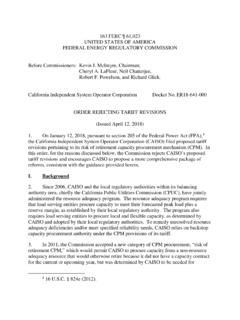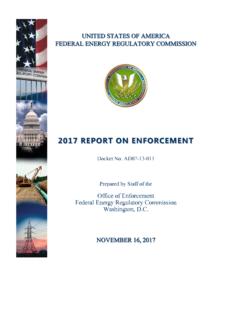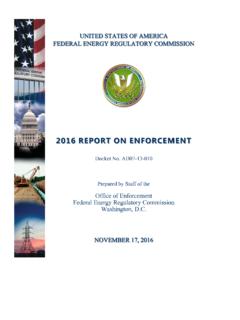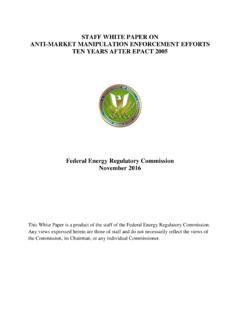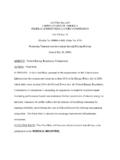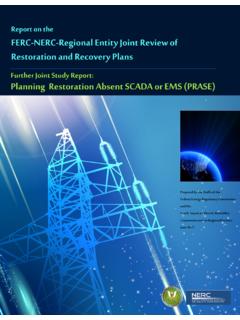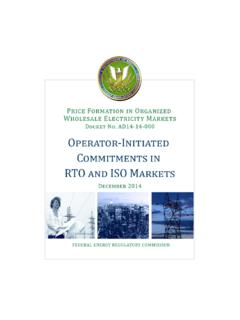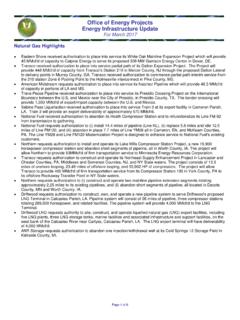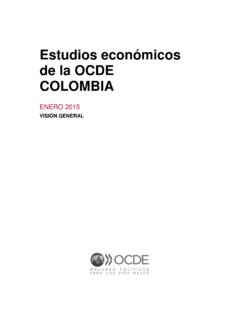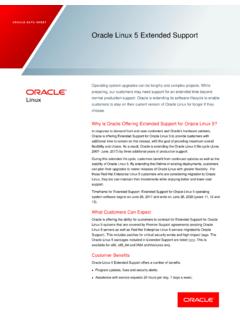Transcription of Staff Analysis of - Federal Energy Regulatory Commission
1 I ii Staff Analysis of uplift in RTO and ISO Markets August 2014 For further information, please contact: William Sauer Office of Energy Policy and Innovation Federal Energy Regulatory Commission 888 First Street, NE Washington, DC 20426 (202) 502-6639 This report is a product of the Staff of the Federal Energy Regulatory Commission . The opinions and views expressed in this paper represent the preliminary Analysis of the Commission Staff . This report does not necessarily reflect the views of the Commission . iii Contents I. Executive Summary .. 1 II. Introduction .. 3 III. uplift Credits .. 4 A. Trends .. 5 B. Concentration .. 7 C. Correlation Between uplift and Potential Market Drivers.
2 10 IV. uplift Charges .. 16 A. Daily Charge Volatility .. 16 B. Frequency of uplift Charge Rates .. 17 V. Transparency .. 21 A. A Comparison of Public and Non-Public uplift Data .. 21 B. Publicly Available RTO and ISO and MMU uplift Data .. 26 Appendices Appendix A .. 29 Appendix 30 Appendix C .. 33 Appendix D .. 38 Appendix E .. 41 1 I. Executive Summary This paper is part of an effort to evaluate matters affecting price formation in the Energy and ancillary services markets operated by Regional Transmission Operators (RTOs) and Independent System Operators (ISOs) subject to the jurisdiction of the Federal Energy Regulatory Commission (FERC or Commission ). It covers the period 2009-2013 and focuses on the levels, trends, volatility and transparency of uplift costs.
3 Data underlying this report were submitted confidentially to the Commission and have been aggregated to an appropriate level to mask the underlying As noted by the Commission in the public notice announcing the commencement of a proceeding to evaluate price formation issues, locational marginal prices for Energy and ancillary services ideally would reflect the true marginal cost of production, taking into account all physical system constraints, and fully compensate all resources for the variable cost of providing The RTOs and ISOs would not need to commit any additional resources beyond those resources scheduled economically; load would reduce consumption in response to price signals such that market prices would reflect the value of electricity consumption without the need to administratively curtail load.
4 In reality, however, RTO and ISO Energy and ancillary services market outcomes are impacted by a number of technical and operational Modeling, software and certain other limitations are, to some extent, inherent in the complexity of the electric system and the tools available today to maintain reliable For example, technical limitations in the market software prevent RTOs and ISOs from fully modeling all of the system s physical constraints. If physical constraints ( , voltage constraints) are not accurately reflected in the system model used to clear the market, the software outcome may not clear the resources needed to resolve all such constraints. In such a case, system operators may have to manually dispatch a resource that is needed to resolve a constraint (and manually re-dispatch other resources), with resulting Energy and ancillary service prices not reflecting the marginal cost of production.
5 RTOs and ISOs provide make- 1 Commission Staff appreciates the responsiveness of the RTOs and ISOs in addressing questions about uplift in their regions. 2 See Notice, Price Formation in Energy and Ancillary Services Markets Operated by Regional Transmission Organizations and Independent System Operators, Docket No. AD14-14-000 (June 19, 2014). 3 Although the discussion herein focuses on RTO and ISO markets, similar technical and operational limitations also impact the efficient commitment of resources by electric utilities operating in other market structures. 4 Other efforts, like the annual market software conference, are intended to make progress on these longer term issues.
6 See 2 whole payments, or uplift payments, to resources whose commitment and dispatch resulted in a shortfall between the resource s offer and the revenue earned through market clearing prices. Nonetheless, understanding the reasons for uplift payments, the magnitude of uplift payments, and the impact on market participants and customers may help to shed light on markets, operations or infrastructure improvements to reduce the need for uplift payments. Preliminary findings indicate that: uplift payments ( , credits) have been highly concentrated and recurring on a geographic or resource basis. uplift payments are closely related to market fundamentals, including Energy and fuel costs. uplift payments are closely related to price divergences between day-ahead and real-time markets.
7 The volatility of uplift costs varies across RTOs and ISOs and is trending upwards in three of the five markets studied. uplift payments and the reasons they are incurred lack transparency. This paper is intended to spur discussion and lead to a more comprehensive understanding of the drivers and market impacts of uplift costs. The conference scheduled for September 8, 2014, will provide one opportunity to learn the views of market participants, RTOs and ISOs, and market monitoring units (MMU). Regardless of the underlying causes of uplift , a failure to make the causes transparent and to price them into the Energy and ancillary services markets can undermine the effectiveness of price signals and efficient system utilization, and mute investment signals.
8 Volatile uplift charges may also create financial uncertainty for customers, depress liquidity and reduce market efficiency. 3 II. Introduction This paper explores historical trends and characteristics of uplift and the statistical relationship between uplift and certain market fundamentals in the wholesale markets of California Independent System Operator (CAISO), ISO New England, Inc. (ISO-NE), Midcontinent Independent System Operator (MISO), New York Independent System Operator (NYISO) and PJM Interconnection, LLC (PJM).5 It is organized around three topics: uplift credits, uplift charges and data transparency. Throughout this paper the term uplift credit refers to a payment to a generator or other resource and uplift charge refers to an RTO s or ISO s recovery of uplift costs from market participants.
9 This paper does not attempt to assess whether uplift costs are too high or too low or whether specific uplift costs are warranted. Rather, the Analysis presented here is intended to facilitate discussions concerning the matter of uplift as it affects price formation in the RTO and ISO Energy and ancillary services markets. It is worth noting that costs giving rise to uplift payments, such as commitment costs, are not unique to RTO and ISO markets. These costs are inherent in reliably operating any electric transmission system. Two sources of data were used. Data for the period 2009-2011 were obtained from each RTO and ISO in response to a FERC Staff data request and includes: (1) daily uplift credits ( uplift credits are calculated based on total revenues and costs for a given calendar day) and details on why individual uplift credits were made; (2) details on resources receiving uplift payments, including fuel and driver types ( , steam turbine or combustion turbine) and output capabilities; (3) bid information and marginal cost estimates during periods when uplift credits were made; and (4) details on uplift charges.
10 Data for 2012 and 2013, where available, were obtained from RTO and ISO data submissions pursuant to Order No. Note that due to incomplete data not every Analysis reported in this paper covers the complete period 2009-2013. 5 Southwest Power Pool is not included in this report because its day-ahead market was launched in 2014. 6 Enhancement of Electricity Market Surveillance and Analysis through Ongoing Electronic Delivery from Regional Transmission Organizations and Independent System Operators, Order No. 760, FERC Stats. & Regs. 31,330 (2012). Paragraph 35 of Order No. 760 states the Commission may make publicly available Staff white papers, among other things, that contain analyses derived from data that the Commission uses.
